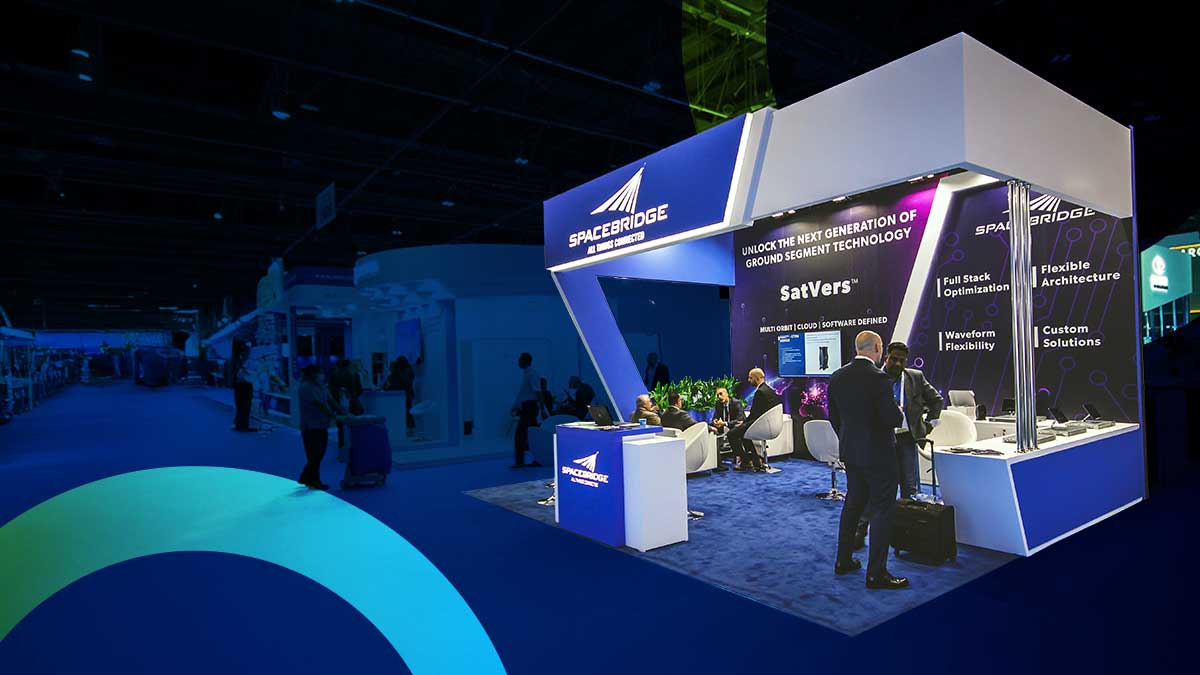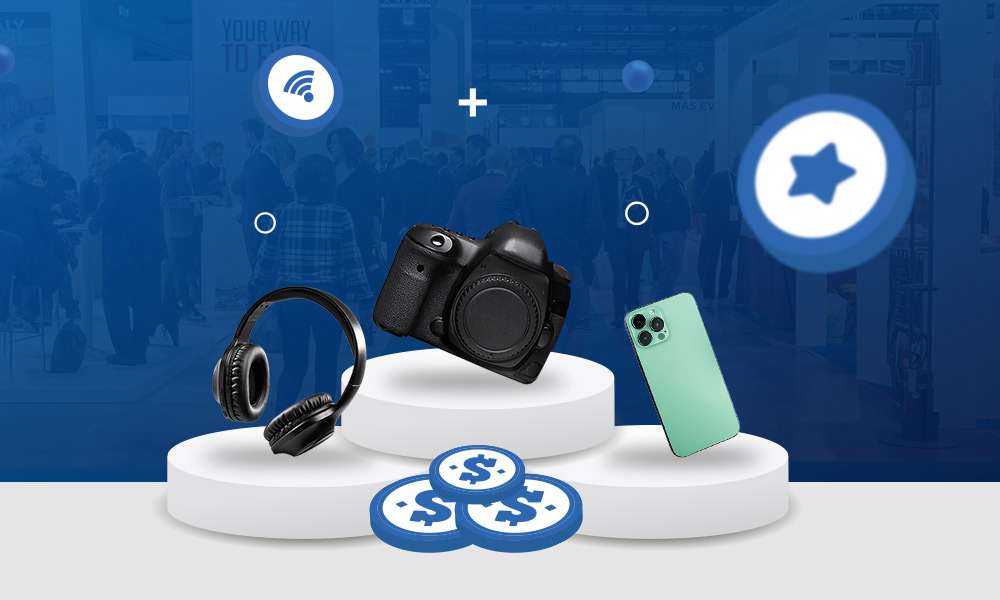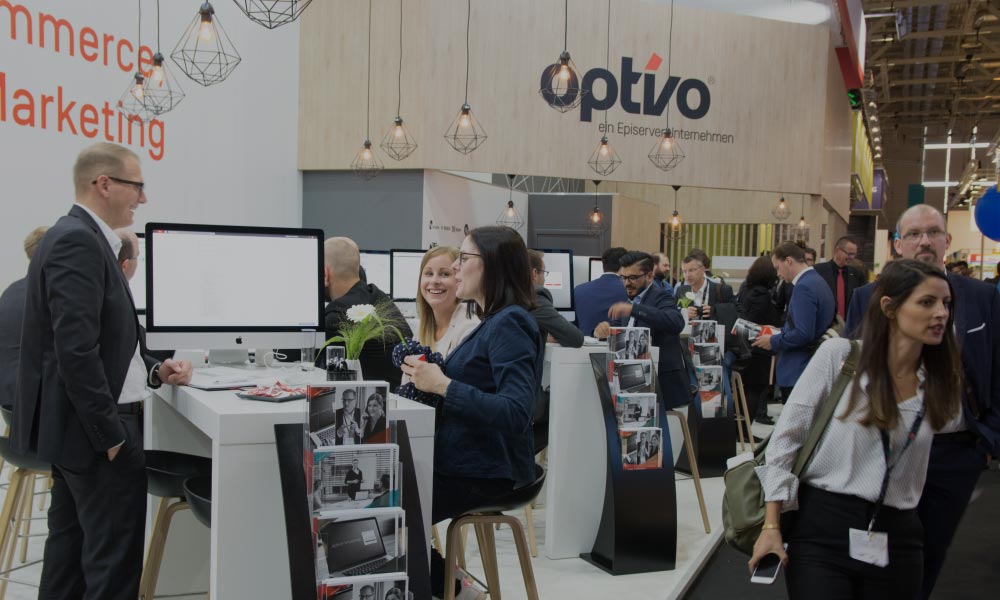Trade Show Booth Design Best Practices
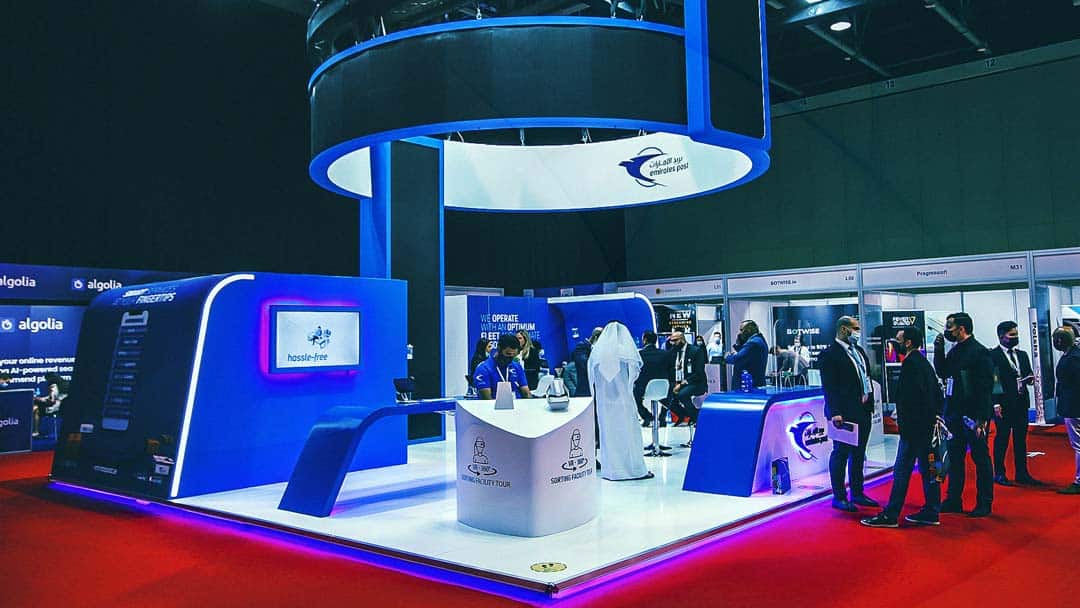
Trade shows prove to be a treasure trove for B2B enterprises—an opportunity to exhibit your merchandise and engage in direct interactions with potential customers.
However, let’s face it: a mundane booth tends to get overshadowed by the crowd. This is where the enchantment of an exceptional booth design steps in!
Embracing trade show booth design best practices is beneficial and essential for making a significant impact. A great way to captivate and engage attendees is through meticulous exhibit design.
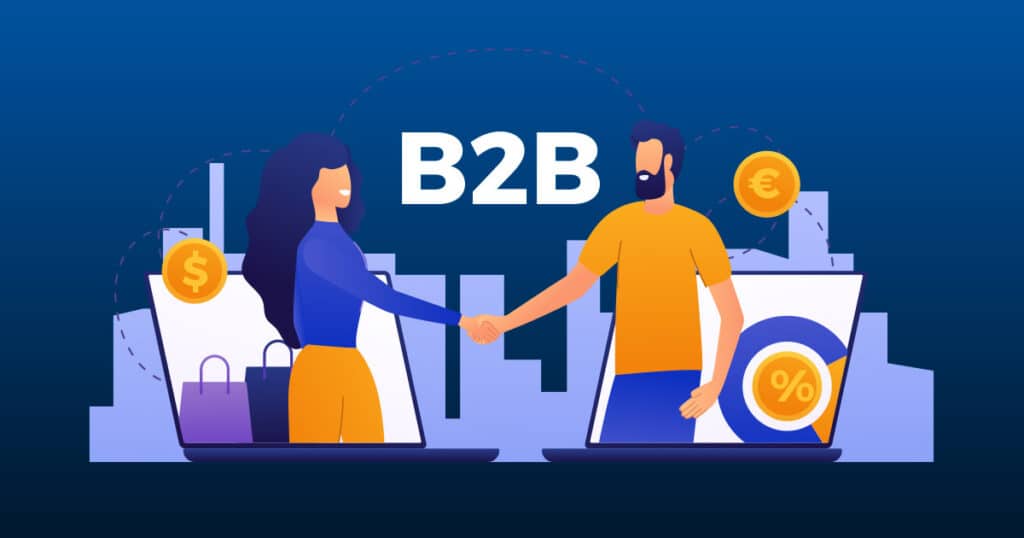
Mastering these design techniques can make all the difference between an unremarkable encounter and a resounding success—increasing the effectiveness of your trade show. Are you prepared to grab attention (and generate leads) at your upcoming trade show? Let’s discuss crafting a booth that truly stands out!
Key trade show booth design best practices include:
- Creating a successful design that resonates with the intended audience and objectives
- Emphasizing the importance of branding and visual appeal
- Integrating interactive features and technological advancements
- Interacting with attendees at trade shows by offering tailored experiences
By utilizing these tactics, businesses targeting other businesses can enhance their return on investment (ROI) and reach their trade show goals, such as generating leads, increasing brand awareness, and showcasing products or services.
Understanding Your Audience and Goals

Pre-Design Considerations
Hold on a sec, trade show rockstar! Before you dive headfirst into designing your booth, let’s pump the brakes for a quick pit stop. Taking a moment to consider a few key factors upfront will ensure your booth is a total hit.
This way, your design choices will perfectly align with your goals and the audience you want to attract. Ready to create a trade show experience that wows? Let’s strategize first!
Defining Your Target Audience
It’s important to know your audience well when designing a booth that connects with attendees. Take into account the aspects like:
- Job titles and responsibilities
- Industry and field
- Challenges and problems they face
- Hobbies and likes
By thoroughly understanding your target visitor, you can customize your booth’s layout, messaging, and interaction approaches to suit their requirements and interests.
Setting Clear Goals
Establish specific, measurable goals for your trade show participation. Common objectives include:
| Goal | Description |
| Lead Generation | Collecting contact information from potential customers |
| Brand Awareness | Increasing visibility and recognition of your brand |
| Product Demos | Showcasing your products or services to attendees |
Align your goals with your overall marketing and business objectives to ensure a cohesive strategy.
Aligning Booth Design with Audience and Goals
Your booth design is just like a firm handshake at a trade show. It sets the tone right from the start! The trick is to ensure it resonates with your target audience and aligns with your objectives.
- Looking to attract leads? Clearly outline desired actions with compelling calls to action and user-friendly ways for them to share their information.
- Focusing on boosting brand awareness? Let your brand’s unique identity shine through in your design elements and messaging.
- Showcasing a product demo? Infuse excitement and interactivity through engaging displays and designated areas for people to experience it firsthand.
The key lies in tailoring your booth design to cater to your audience and objectives. By doing so, you can craft a space that captivates attention, conveys your message effectively, and ignites enthusiasm about what you have to offer!

Determining Budget and Booth Size
Planning a killer trade show booth? Here’s the lowdown on what goes into designing it. The size and budget will play a big role in shaping your booth. Think about:
- Space: How much room do you have, and is it open or tucked in a corner?
- Costs: Rentals, purchases, and build-out fees can add up quickly.
- Design & Setup: Factor in the cost of bringing your vision to life.
- Logistics: Shipping and storage add to the final bill.
Work with your team to set a realistic budget and choose a booth size that allows for an excellent design without breaking the bank. By nailing these pre-design details, you’ll lay the foundation for a trade show booth that grabs attention, delivers your message clearly, and helps you achieve your goals.
Essential Design Elements

You’ve got the logistics down pat, but now it’s all about shining the spotlight on your booth! The secret? Crafting a memorable experience for visitors.
Picture your booth design as a puzzle – each element plays a crucial role in presenting your brand and making a lasting impact. We’re here to lend a hand!
Let’s delve into some key pointers to guarantee that your booth stands out from the crowd. Get set for a journey as we elevate your space from mundane to genuinely breathtaking!
Branding
First impressions matter, especially at trade shows! Make sure your booth screams your brand from the rooftops. Here’s the lowdown:
- Rock Your Logo: This is a no-brainer. Make your company logo the star of the show!
- Color Coordination: Consistency is key. Stick to your brand’s color palette to create a cohesive look.
- Font Fun: Keep your fonts consistent with your brand too. No weird mismatches here!
- Eye-Catching Images: Throw in some stunning visuals that align with your brand. Think photos, graphics, the whole shebang!
But it’s not just about looking good. Your booth should also tell your brand story. Use messaging and design elements that showcase your brand’s personality and make you stand out from the crowd.
Layout and Flow
A vibrant booth catches the eye, but captivating visitors is what truly counts. Here are some suggestions to craft a seamless encounter that leaves a lasting impact:
1. Set the Stage: First impressions matter! Design your booth to exude warmth and friendliness, creating an inviting environment where people feel comfortable and welcomed. Providing cozy seating and welcoming faces can make a significant difference.
2. Foster Conversations: Consider your booth layout as a conversation starter. Ensure it is easy to navigate, with clear pathways directing visitors towards your key attractions.
3. Demonstrate, Not Describe: Say goodbye to overwhelming brochures! Allocate space for live demonstrations and interactive showcases. Allowing individuals to interact with your products leads to a far more memorable experience than merely handing out paper materials.
Adhering to these straightforward guidelines allows your exhibition booth to evolve from a static showcase into an interactive experience that draws in potential customers and nurtures enduring relationships. The key lies in creating an environment where people are eager to learn, enjoy themselves, and engage with your brand!
| Booth Size | Recommended Layout |
| 10×10 | Inline or corner |
| 10×20 | Peninsula or island |
| 20×20+ | Island |
How to design trade show booth graphics?
Graphics and signage are crucial in attracting visitors and communicating your message. When designing your graphics and signage, keep the following best practices in mind:
Studies show that attendees spend an average of 3-5 seconds scanning a trade show booth. Ensure your graphics and signage effectively communicate your key message within this brief timeframe.
Product Displays and Demonstrations
So, you’ve scored a sweet spot at a trade show? That’s fantastic! Now, how can you make sure your booth steals the spotlight? Check out these top-notch tips to present your products or services in a way that grabs people’s attention.
- Say goodbye to boring booth designs! Think eye-catching visuals and layouts that shout, “Check us out!” Bold colors and striking graphics are key.
- Looking to kick it up a notch? Incorporate interactive features like touchscreens or VR experiences to spark conversations. Let attendees get hands-on (virtually or literally!) and experience your product firsthand.
- Demos and product trials are always crowd favorites. They give visitors a chance to try things out and see what your product is all about.
- Never underestimate the impact of good lighting and design! Smart use of these elements can transform your booth into a magnet, pulling in visitors and making it a must-visit spot at the event.
Lighting and Ambiance
Lighting and ambiance can significantly impact your trade show booth’s overall look and feel. Use lighting strategically to:
- Highlight key areas, such as product displays or branding elements
- Create a warm and inviting atmosphere
- Enhance the visual impact of your graphics and signage
In addition to lighting, consider other ambiance-enhancing elements, such as:
- Flooring and carpeting
- Color schemes
- Furniture and décor
Technology Integration
Integrating technology into your booth design can help you engage visitors, capture leads, and create memorable experiences. Consider incorporating elements such as:
- Interactive touch screens or kiosks
- Virtual or augmented reality experiences
- Digital lead capture systems
- Social media walls or hashtag displays
By carefully planning and executing these essential design elements, you can create a trade show booth display that effectively showcases your brand, engages visitors, and achieves your goals.
Measuring and Optimizing Success

You’ve worked hard to design an amazing trade show booth and engage your audience, but how do you know if your efforts were truly successful? In this section, we’ll discuss the essential metrics to track, the importance of data analysis, and how to continuously improve your trade show performance.
Defining Key Performance Metrics
To measure the success of your trade show booth, you need to establish clear, quantifiable metrics that align with your goals. Some key performance indicators (KPIs) to consider include:
Data Tracking and Analysis
To effectively measure your KPIs, you need a system for tracking and analyzing data. Consider the following tools and strategies:
- Lead capture software: Use digital lead capture tools, such as badge scanners or mobile apps, to streamline the process of collecting and organizing lead information.
- Surveys and feedback forms: Create brief surveys or feedback forms to gather insights from visitors about their experience with your booth and brand.
- Analytics platforms: Utilize tools to track visitor behavior, such as booth traffic patterns, dwell times, and engagement with interactive elements.
Continuous Improvement for Future Trade Shows
Measuring your success is just the first step – the real value lies in continuously using those insights to improve your trade show performance. After each event, take the time to:
Analyze your data
Review your KPIs and identify areas of strength and weakness. Look for patterns and trends that can inform future strategies.
Gather team feedback
Conduct a post-show debrief with your team to discuss what worked well, what could be improved, and any key learnings from the event.
Refine your approach
Based on your data analysis and team feedback, make data-driven decisions to optimize your booth design, audience engagement strategies, and overall trade show approach for future events.
Test and iterate
Don’t be afraid to experiment with new design ideas and tactics. Continuously test and refine your approach to find what works best for your brand and audience.
By defining clear metrics, tracking and analyzing data, and continuously refining your approach, you can ensure that your trade show investments drive meaningful results for your business. Remember, success is an ongoing process – by staying agile and adaptable, you can optimize your trade show performance and achieve your goals year after year.
Common Mistakes to Avoid
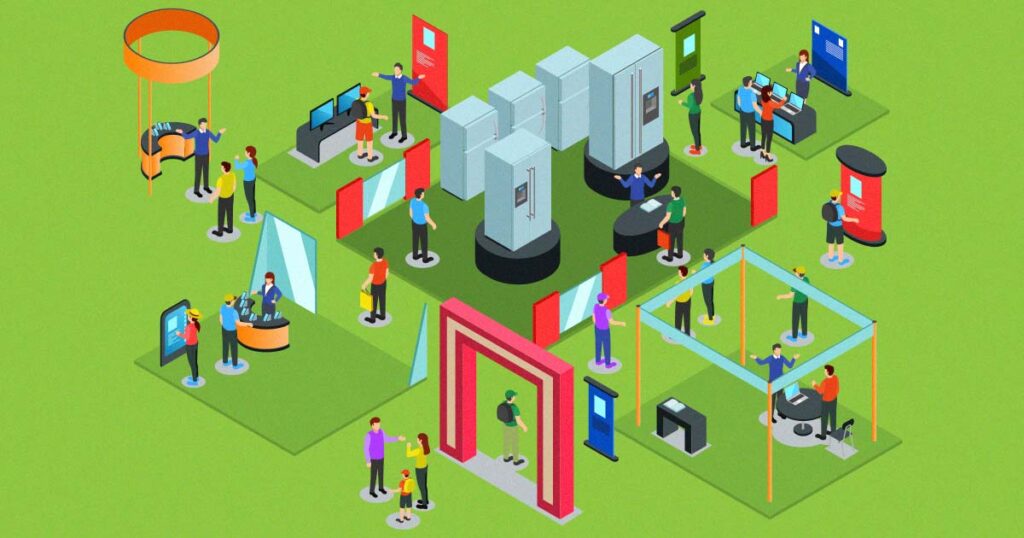
Even with the best intentions and a well-designed booth, it’s easy to fall prey to common trade show pitfalls. To ensure your success, be mindful of these potential missteps and take proactive steps to avoid them.
Cluttered or Confusing Messaging
Consider your trade show booth like a first date – aim to leave a positive impact without bombarding them with too much information.
People’s attention spans are limited, so ensure your message is straightforward and to the point. Bullet points, brief statements, and captivating visuals will be key to capturing their interest.
Highlight what sets your brand apart, and allow that distinctive quality to stand out! You’ll draw in inquisitive attendees and ignite valuable discussions by keeping things uncomplicated and honest.
Poor Lighting and Visibility
Don’t underestimate the power of lighting in your booth design. Poor lighting can make your booth appear dull, uninviting, or invisible among competitors. Ensure your booth is well-lit, with strategic spotlights highlighting key areas such as product displays or branding elements.
In addition to lighting, consider your booth’s overall visibility. Make sure your signage is positioned at eye level and can be easily read from a distance. Use contrasting colors and bold fonts to make your booth stand out on the trade show floor.
Lack of Brand Consistency
Inconsistent branding can confuse visitors and dilute your brand’s impact. Ensure that all booth design elements – from graphics and signage to staff attire and promotional items – align with your brand guidelines.
Failing to Engage Visitors
Don’t make the mistake of treating your booth as a static display. Actively engage visitors through interactive demonstrations, personalized conversations, and memorable experiences.
Train your booth staff to be proactive in initiating conversations and guiding visitors through your booth. Encourage them to ask open-ended questions, listen attentively, and tailor their responses to each visitor’s unique needs and interests.
Visitor Engagement Tips:
- Greet visitors with a smile
- Ask open-ended questions
- Listen actively
- Personalize your approach
- Offer interactive experiences
Avoid these common mistakes and focus on creating a clear, consistent, and engaging trade show experience! You’ll be well-positioned to achieve your goals and make a lasting impression on your target audience.
In today’s competitive B2B landscape, a well-designed trade show booth is a powerful tool for engaging your target audience, generating leads, and driving business growth. By implementing the best practices outlined in this guide, you can create a booth that effectively showcases your brand, communicates your value proposition, and leaves a lasting impression on attendees.
A successful trade show strategy extends beyond just the design of your booth. It also encompasses pre-show planning, audience engagement, and post-show analysis and optimization. By taking a holistic approach and continuously refining your tactics, you can maximize your trade show ROI and achieve your business goals.
Looking to enhance your next trade show display?
Dive into the world of expert booth design ideas with Blue Atlas Marketing, your dedicated partner in trade show marketing services. Our specialized strategies are crafted to seamlessly integrate into your marketing plan, ensuring your booth stands out and captivates your audience at your next trade show.
Whether refreshing your design or creating a new concept, our insights and innovations are tailored to your needs. Elevate your trade show experience with us.
Contact us to discover how Blue Atlas Marketing can transform your trade show presence!


